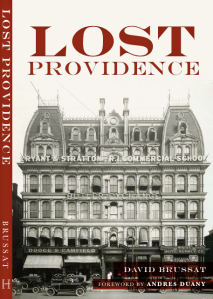
Initial design for proposal on Parcel 6 from architect of shipping container offices. (PBN)
Last week the I-195 commission publicly rejected the Spencer Providence proposal for Parcel’s 2 and 5 on the eastern half of the Route 195 corridor. Of three options presented more than a year ago, it was by far the most widely favored in the Fox Point community. The Spencer proposal, unlike every other project along the corridor (including the Fane tower), would have fit into the historical character of the neighborhood – a feature whose obvious advantages appear to puzzle members of the commission.
Spencer Providence would also have had a grocery store, a grocer having already signed a lease pending the proposal’s approval by the commission. Perhaps the grocer was aware of the community’s support for the project, and figured that the commission would push it forward. The commission seems instead to have backstabbed Spencer by calling for a grocery store to be included in a proposal it solicited more recently on the land next door, Parcel 6, well after Spencer had made its proposal.

The Box Office. (boxoffice460.com)
The Parcel 6 proposal was given a boost last week by the commission. Its developers are responsible for a dreadful office building made of stacked shipping containers (left) in the Promenade industrial district. Shipping containers? In Fox Point? The tedious design atop this post is preliminary, but even it displays evidence that the designers hope to carry their container motif into this project. Give us a break!
Well, we are not going to get a break because the General Assembly has passed Senate President Dominick Ruggerio’s bill to strip Providence of its authority to participate in the planning and design of anything built in the I-195 corridor. This was not a bill to streamline the process, as advertised, but to steamroll the citizens of all 39 cities and towns in case the state wants to develop land it owns over 20 acres. Earlier, the bill was amended to “define” 20 acres in a flexible way that seemed, to this observer, intended to enable future corrupt land dealing among the state and potential developers.
Corruption is wrong, but I am even more upset by the state’s insistence upon ugliness as a key feature of state-sponsored development. (And one way or another, almost all projects in Rhode Island are state-sponsored.) The hurt that corruption does to citizens is sneaky and shows up mainly in the rising cost over time of running the state – partly caused by the disinclination of honest developers to do business in a corrupt state.
Yes, corruption is wrong, but so is the refusal to encourage developers to build projects that are beautiful, or at least that fit into the historic character of the state and its cities and towns – which is widely mandated by local zoning and comprehensive plans, which are almost uniformly ignored by every municipality. In a democracy, the public’s preference for traditional design should be influential, and officials should feel obliged to protect historical character. They do not.
Ruggerio’s legislation illustrates what Nietzsche called the “will to power,” but it also facilitates what we might reasonably call a “will to ugliness” that is already ubiquitous in development here and elsewhere.
The will to ugliness arises because most design professionals – architects, educators, development staff and even preservationist professionals – buy into a century-old design philosophy that architecture “of our time” must embrace a machine aesthetic and reject new buildings that refer to past styles, even if they are preferred by the vast majority of the public. There is no logical argument for this and there never has been, but it is dogma among design professionals anyway. The public tends to detest the results.
Unlike political and financial corruption, which operate hand in glove to offend the wallet silently in the future, the ugliness of almost all public and private development offends the eye in real time, every day. It is pointless to say which is the more abhorrent. It may be argued that ugliness is the more direct and immediate harm. It robs each citizen of beauty, which is part and parcel of the pursuit of happiness. Scientists find more and more evidence each year that ugliness causes anxiety and illness. Why? Because modern architecture rejects the learning embodied in past practices. Traditional design, on the other hand, mimics the reproductive characteristics of nature. Its tendencies are evolutionary rather than experimental, which also makes it more sustainable environmentally.
Research shows that design preferences reflect more than just personal taste. The preference for traditional design is intuitive whereas the preference for modernist design is learned. That means that it can be unlearned much more easily than political and financial corruption that was baked into the greed of human nature more permanently than mere aesthetic error, which was hatched by a few disgruntled men in the 1920s.
It is unlikely that the I-195 commission is capable of unlearning the error of its ways. But it is not impossible.
Since building what people like is easier on the development process than building what people don’t like, learning the right way to develop can be easily done, swiftly, with no need for new legislation, and at almost no cost. Which is good, because the future of Providence depends on it.

Spencer Providence proposal rejected by I-195 commission. (Greater City Providence)



Pingback: {bits & pieces} ~ Like Mother Like Daughter
Shouldn’t Steve weigh in on this? Or is he only paid to promote the Fane tower?
LikeLike
Smith Hill needs a makeover!…
Polenta Politics are holding Rhode Island back!
Enough!…
LikeLike
They need to be educated and one would hope that the existing structures in Fox Point would create an aesthetic. Yes, there is something so weird about designing a building of storage containers. YOU LINK CORRUPTION AND ARCHITECTURAL UGLINESS–WHAT IS THE CONNECTION?
LikeLike
The connection, Coleman, between political/financial corruption on the one hand and architectural ugliness on the other is that both involve actors in the public realm acting against the public. Both are corrupt practices. The former involve greed and money, the latter involves a self-interested denial of obvious truths – in short, greed and money. The one hurts now, the other hurts later – unless it is caught and prevented by the criminal justice system. Ugliness is never “caught” in the same sense, because modernists have been able to successfully convince the right people that there’s nothing wrong with ugliness.
LikeLike
Colemanjenkes, See above,… hahahaaa…!
LikeLike